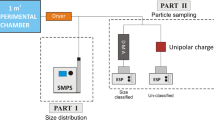Abstract
The aim of this article is to understand the surface quality, as well as the emission and dispersion of dust particles generated during dry polishing of granite, with a view to minimizing both surface roughness and dust particles emission by optimizing the parameters of the industrial process. The optimized polishing parameters found must have a good influence on both the surface quality and the dust particles emission. Investigating dust particle dispersion will help with the design of ventilation solutions to capture dust during the polishing process. Results show that the spindle speed and the feed rate of the polishing tool have important influence on the surface quality and the dust particles emission during the dry polishing process. Choosing a spindle speed of approximately 1500 rpm and an average feed rate of 17 mm/s to perform the dry polishing of granite is a good compromise, which leads to minimize dust particles emission while achieving a good surface finish. It is also shown that the dust emitted contaminates in the same way the vicinity and near the polishing tool. The dust particles, emitted during dry polishing of granite, belong to PM2.5 (particles less than 2.5 μm in diameter). These particles, once inhaled, easily reach the lung alveolar region and cause serious injuries.











Similar content being viewed by others
References
Vacek PM, Verma DK, Graham WG, Callas PW, Gibbs GW (2011) Mortality in Vermont granite workers and its association with silica exposure. Occup Environ Med 68(5):312–318. https://doi.org/10.1136/oem.2009.054452
McDonald JC, McDonald AD, Hughes JM, Rando RJ, Weill H (2005) Mortality from lung and kidney disease in a cohort of North American industrial sand workers: an update. Ann Occup Hyg 49(5):367–373. https://doi.org/10.1093/annhyg/mei001
Verma DK, Vacek PM, des Tombe K, Finkelstein M, Branch B, Gibbs GW, Graham WG (2011) Silica exposure assessment in a mortality study of Vermont granite workers. J Occup Environ Hyg 8(2):71–79. https://doi.org/10.1080/15459624.2011.543409
Cox LAT Jr (2011) An exposure-response threshold for lung diseases and lung cancer caused by crystalline silica. Risk Anal 31(10):1543–1560. https://doi.org/10.1111/j.1539-6924.2011.01610.x
Steenland K, Ward E (2014) Silica: a lung carcinogen. CA Cancer J Clin 64(1):63–69. https://doi.org/10.3322/caac.21214
Cooper J (2012) Global occupational hazard: silica dust. ASME 2012 Int Mech Eng Congr Expo 5(45219):355–360. https://doi.org/10.1115/IMECE2012-87509
Rushton L (2007) Chronic obstructive pulmonary disease and occupational exposure to silica. Rev Environ Health 22(4):255. https://doi.org/10.1515/REVEH.2007.22.4.255
Ahmad I, Khan MI, Patil G (2011) Nanotoxicity of occupational dust generated in granite stone saw mill. 2011 Int Conf Nanosci Technol Soc Implic 1-6. doi:https://doi.org/10.1109/NSTSI.2011.6111990
Kusaka T, Nakayama M, Nakamura K, Ishimiya M, Furusawa E, Ogasawara K (2014) Effect of silica particle size on macrophage inflammatory responses. PLoS One 9(3):e92634. https://doi.org/10.1371/journal.pone.0092634
Xu XP, Huang H, Li Y (2003) Material removal mechanisms in diamond grinding of granite, Part 1: the morphological changes of granite from sawing to grinding. Key Eng Mater 250:215–221
Saidi MN, Songmene V, Kouam J, Bahloul A (2015) Experimental investigation on fine particle emission during granite polishing process. Int J Adv Manuf Technol 81(9-12):2109–2121. https://doi.org/10.1007/s00170-015-7303-z
Li Y, Huang H, Xu XP (2006) Gloss formation and its relationship with roughness in granite grinding. Key Eng Mater 304-305:413–416
Kouam J, Songmene V, Bahloul A (2013) Experimental investigation on PM2.5 particle emission during polishing of granite. Health 05(10):29–35. https://doi.org/10.4236/health.2013.510a2004
Yavuz H, Ozkahraman T, Demirdag S (2011) Polishing experiments on surface quality of building stone tiles. Constr Build Mater 25(4):1707–1711. https://doi.org/10.1016/j.conbuildmat.2010.10.016
Yaonan C, Li L, Haiting W, Mingyang W, Yizhi L (2014) Investigations on the dust distribution characteristics of dry milling using inserts with various groove profiles. Int J Adv Manuf Technol 74(1-4):551–562. https://doi.org/10.1007/s00170-014-6019-9
Saidi MN, Songmene V, Kouam J, Bahloul A (2018) Rotational and translation-free polishing of granite: surface quality and dust particles emission and dispersion. Int J Adv Manuf Technol 98(1):289–303. https://doi.org/10.1007/s00170-018-2247-8
ROHS (2019) Regulation respecting occupational health and safety. Légis Québec. http://legisquebec.gouv.qc.ca/fr/showdoc/cr/S-2.1,%20r.%2013. Accessed 14 January 2019
OSHA (2012) Silica, crystalline, mixed respirable (quartz, cristobalite, tridymite). Occupational Safety and Health Administration, U.S. Department of Labor. https://www.osha.gov/chemicaldata/chemResult.html?RecNo=278. Accessed 06 December 2018
Johnson DL, Phillips ML, Qi C, Van AT, Hawley DA (2017) Experimental evaluation of respirable dust and crystalline silica controls during simulated performance of stone countertop fabrication tasks with powered hand tools. Ann Work Expo Health 61(6):711–723. https://doi.org/10.1093/annweh/wxx040
Akbar-Khanzadeh F, Milz S, Ames A, Susi PP, Bisesi M, Khuder SA, Akbar-Khanzadeh M (2007) Crystalline silica dust and respirable particulate matter during indoor concrete grinding—wet grinding and ventilated grinding compared with uncontrolled conventional grinding. J Occup Environ Hyg 4(10):770–779. https://doi.org/10.1080/15459620701569708
Croteau GA, Guffey SE, Flanagan ME, Seixas NS (2002) The effect of local exhaust ventilation controls on dust exposures during concrete cutting and grinding activities. AIHA journal: a journal for the science of occupational and environmental health and safety 63(4):458–467
Songmene V, Kouam J, Balhoul A (2018) Effect of minimum quantity lubrication (MQL) on fine and ultrafine particle emission and distribution during polishing of granite. Measurement 114:398–408. https://doi.org/10.1016/j.measurement.2017.10.012
Company EK (2004) Kodak’s ergonomic design for people at work. Second edn. Wiley, Hoboken
Djebara A (2012) Métrologie des particules ultrafines d’usinage: optimisation de la caractérisation et de la mesure. École de technologie supérieure (Montreal, Quebec, Canada),
Acknowledgments
This study is part of a larger research project on polishing granite funded by the Institut de Recherche Robert-Sauvé en Santé et Sécurité du Travail (IRSST). The authors also wish to thank A. Lacroix Granit (Saint-Boniface, Quebec, Canada) for donating the samples used in the experiments.
Author information
Authors and Affiliations
Corresponding author
Additional information
Publisher’s note
Springer Nature remains neutral with regard to jurisdictional claims in published maps and institutional affiliations.
Rights and permissions
About this article
Cite this article
Saidi, M.N., Songmene, V., Kouam, J. et al. Study of surface quality and dust particles emission and dispersion during dry polishing of granite. Int J Adv Manuf Technol 104, 4675–4684 (2019). https://doi.org/10.1007/s00170-019-04166-3
Received:
Accepted:
Published:
Issue Date:
DOI: https://doi.org/10.1007/s00170-019-04166-3



